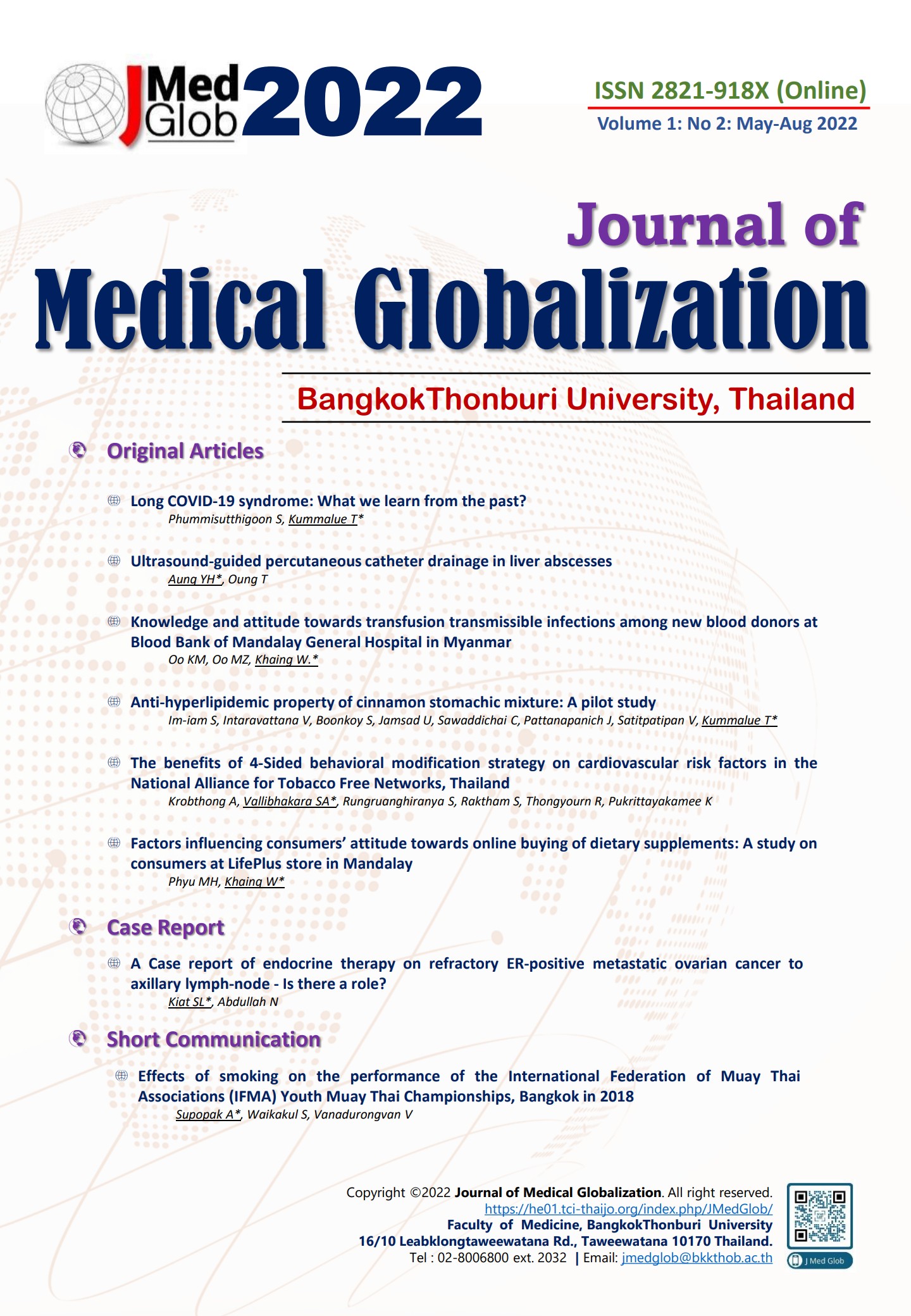Knowledge and Attitude towards Transfusion Transmissible Infections among New Blood Donors at Blood Bank of Mandalay General Hospital in Myanmar
Keywords:
Attitude, Blood bank, Knowledge, New blood donor, Transfusion transmissible infectionsAbstract
Objectives: To study the level of knowledge and attitude towards transfusion transmissible infections among new blood donors at blood bank of Mandalay general hospital in Myanmar.
Materials and Methods: From April 1st to December 31st, 2016, a cross-sectional descriptive study was conducted among 406 new blood donors at blood bank of Mandalay general hospital in Myanmar. Participants in this study were interviewed using structured questionnaires. Stata 13 was used to conduct the statistical analysis.
Results: About 53.7% of new blood donors were males and 46.3% were females. Regarding knowledge level, a high percentage of new blood donors (87.7%) had low knowledge of transfusion transmissible infections, while 12.3% had high knowledge. Almost all new blood donors (98.5%) had a positive attitude, with only a few (1.5%) having a negative attitude.
Conclusion: Despite a high percentage of low knowledge among new blood donors at blood bank of Mandalay General Hospital in Myanmar, there was a positive attitude towards transfusion transmissible infections. A positive attitude can result from adequate knowledge, which can lead to good practices. It is recommended that the community be educated on the prevention of transfusion transmissible infections and safe blood transfusion.
References
Toby LS, Jeffrey JM, Edward LS, Bjarte GS, Ronald GS. Rossi’s Principles of Transfusion Medicine. 5th ed. Chichester: Wiley-Blackwell Publishing; 2016.
Jeffrey JM. Transfusion Medicine. 3rd ed. Chichester: Wiley-Blackwell Publishing; 2012.
Feyisa T, Tesfaye Kiya G, Maleko WA. Assessment of recipients’ characteristics, transfusion appropriateness, and utilization pattern of blood and blood products in Jimma Medical Center, Jimma, Ethiopia. PLoS ONE. 2021; 16(4): 1-17.
Arshad A, Borhany M, Anwar N, et al. Prevalence of transfusion transmissible infections in blood donors of Pakistan. BMC Hematol. 2016; 16(27): 1-6.
Kebede E, Getnet G, Enyew G, Gebretsadik D. Transfusion Transmissible Infections Among Voluntary Blood Donors at Dessie Blood Bank, Northeast Ethiopia: Cross-Sectional Study. Infect Drug Resist. 2020; 13: 4569-4576.
Tulika CS, Rizvi NF, Agarwal D. Decreasing Prevalence of Transfusion Transmitted Infection in Indian Scenario. Sci. World J. 2014; 14: 1-4.
Ataro Z, Urgessa F, Wasihun T. Prevalence and Trends of Major Transfusion Transmissible Infections among Blood Donors in Dire Dawa Blood bank, Eastern Ethiopia: Retrospective Study. Ethiop J Health Sci. 2018 Nov; 28(6): 701-710.
Alfouzan N. Knowledge, Attitudes, and Motivations towards Blood Donation among King Abdulaziz Medical City Population. Int J Fam Med. 2014; 2014: 1-8.
Aung T. Status report of the blood transfusion services in Myanmar. Asian J Transfus Sci. 2009 Jan; 3(1): 22-25.
World Health Organization. WORLD BLOOD DONOR DAY 2018. [Internet] 2018. [Cited 2022 June, 15]. Available from: https://www.who.int/campaigns/world-blood-donor-day/2018/who-can-give-blood
World Health Organization. Blood safety and availability. [Internet] 2018. [Cited 2022 June, 15]. Available from: https://www.who.int/news-room/fact-sheets/detail/blood-safety-and-availability
Daneshi S, Davarani ER, Arefi F, Mehr FJ, Hushmandi K, Raei M, Fariabi R, Shahrokhabadi MS. Factors affecting blood donation intervals and patterns of return based on a sample in southern Iran: A follow-up design. Russian Open Med J 2021; 10(4): 1-5.
Kasraian L, Ashkani-Esfahani S, Foruozandeh H. Reasons of under-representation of Iranian women in blood donation. Hematology, Transfusion and Cell Therapy. 2021; 43(3): 256-262.
Sasaki S, Funasaki Y, Kurokawa H, Ohtake, F. Blood type and blood donation behaviors: An empirical test of pure altruism theory, ISER Discussion Paper, No. 1029, Osaka University, Institute of Social and Economic Research (ISER), Osaka. 2018. Available from https://www.econstor.eu/bitstream/10419/197702/1/1022457691.pdf
Garg P, Upadhyay S, Chufal SS, Hasan Y, Tayal I. Prevalance of ABO and Rhesus Blood Groups in Blood Donors: A Study from a Tertiary Care Teaching Hospital of Kumaon Region of Uttarakhand. J Clin Diagn Res. 2014; 8(12): 16-19.
World Health Organization. What is the most common blood type? [Internet] 2022. [Cited 2022 June, 19]. Available from: https://doh.gov.ph/node/1447
Beyene GA. Voluntary blood donation knowledge, attitudes, and practices in central Ethiopia. Int J Gen Med. 2020; 13: 67–76.
World Health Organization. Voluntary unpaid blood donations much increase rapidly to meet 2020goal. [Internet] 2016. [Cited 2022 June, 17]. Available from: https://www.who.int/news/item/ 13-06-2016-voluntary-unpaid-blood-donations-must-increase-rapidly-to-meet-2020-goal
Tan PP, Mohamed Fauzi H, Bahar R, Chang CT, Abdul Rahim NA. Knowledge and perceptions of blood safety among blood donors in Kelantan, Malaysia. Malays J Med Sci. 2019; 26(6): 127–136.
Sabu KM, Remya A, Binu VS, Vivek R. Knowledge, Attitude and Practice on Blood Donation among Health Science Students in a University campus, South India. Online J Health Allied Scs. 2011; 10(2): 1-3.
Suen LKP, Siu JY, Lee YM, et al. Knowledge level and motivation of Hong Kong young adults towards blood donation: a cross-sectional survey. BMJ Open 2020; 10: 1-8.
Nwogoh B, Aigberadion U, Nwannadi AI. Knowledge, Attitude, and Practice of Voluntary Blood Donation among Healthcare Workers at the University of Benin Teaching Hospital, Benin City, Nigeria. J Blood Transfus. 2013; 1-6.
Published
How to Cite
Issue
Section
License
Copyright (c) 2022 Journal of Medical Globalization

This work is licensed under a Creative Commons Attribution-NonCommercial 4.0 International License.








